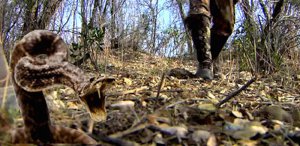How far away is death?

Watch out for snakes!
It’s that time of year when, during warmer temperatures, you are either working in or enjoying the outdoors. Outside, you have plenty to occupy your attention but there’s one more must-do that should be on your visual radar: Watch out for snakes and take care to avoid any incident or injury due to the presence of a snake. (Most people are afraid of snakes; many run-stumble-and-fall type accidents with head injuries occur as a result of a snake encounter.)
Snakebites by the numbers
Snakes are known for being sneaky and hiding in the most unlikely places. Keeping an eye out for the growing number of these reptiles is your first defense. About 8,000 people per year in the U.S. receive venomous bites, and an average of five die from those bites, according to the National Institute for Occupational Safety and Health, part of the U.S. Centers for Disease Control and Prevention. The institute cautions “The number of deaths would be much higher if people did not seek medical care.” On a global basis, “Snakebites kill between 81,000 and 138,000 people and disable 400,000 more every year. It’s a problem that is exacerbated by a global shortage of snake anti-venom, especially in rural areas of sub-Saharan Africa and Asia where appropriate healthcare facilities are few and far between” (CNN Wire).
Good news and bad
The good news: Snakebites are rare. The bad news: That could be temporary. Climate change is rendering the traditional habitats of snakes uninhabitable. Migratory habits are changing, intruding on human populations, resulting in spikes in snakebites. Climate change is also playing havoc with snake evolution. A case in point is the Burmese python in Florida. These natives of Southeast Asia have been Florida residents since the 1980s; an unprecedented cold snap in 2010 made the pythons more cold-tolerant. Since then, the Burmese python population in Florida has skyrocketed, decimating native wildlife populations.
Inspection and preparation are key
So, whether you are vacationing or have an occupation that keeps you outdoors much of the time, here are some important safeguards to observe:
- The best thing you can do is to leave the snake alone. If removal is necessary, call a professional.
- When working outdoors, wear toe boots (or, if you are in an area that’s known to have a number of venomous snakes, invest in snake boots or leg covers), a long-sleeved shirt, and long pants. Gloves are a good idea when moving materials.
- Always survey the area where work is to be done prior to beginning the job. Be cautious when moving materials where wildlife could be.
- Anyone performing work in an outdoor environment conducive to being a snake habitat should receive training on hazards involving snakes. Learning to identify poisonous snakes is a smart idea if you work outdoors.
- Use tools to pick up anything on the ground.
- If your employees do work in an area where venomous snakes are known to be present, have a written procedure and a treatment and evacuation plan.

The TapRooT® System trains you to solve problems
Circumstances can crop up anywhere at any time if proper and safe sequence and procedures are not planned and followed. We encourage you to learn and use the TAPROOT® SYSTEM to solve problems.
TapRooT® has a team of investigators and instructors with years of extensive training ready to offer assistance worldwide. We also offer ongoing support to our clients through FREE NEWSLETTERS and ROOT CAUSE TIP VIDEOS, the ROOT CAUSE ANALYSIS BLOG, and our annual GLOBAL TAPROOT® SUMMIT.
Register for a TapRooT® Course
Register for one of our COURSES. We offer a basic 2-DAY COURSE and an advanced 5-DAY COURSE. CONTACT US, or call 865.539.2139 about having a course at your site or for further root cause analysis training opportunities. We’re here to find solutions for you.




Just a point of clarification – “Climate change is also playing havoc with snake evolution” and the example of the Burmese python is used. The Burmese python example is NOT evolution, it is adaptation. There is a difference.
And no, this doesn’t add much value, its just one of those things like “to, two and too” that irk me. 🙂